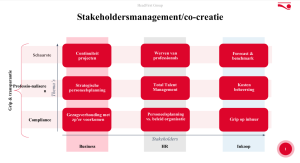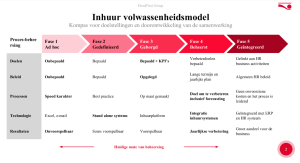10 opportunities to increase budget space for hiring
HR-tech service provider HeadFirst Group is striving for a new world of work, where supply and demand meet using tech and data, the value of talent is prioritized regardless of contract form, and the fight for an inclusive labor market is on. To realize this vision, Managing Director Koen van Rijn challenges organizations to save 10% on hiring costs by hiring 20% more external talent, and offers ten concrete opportunities to meet this challenge.
'Join the next world of work'. The purpose of HR-tech service provider HeadFirst Group, by which it says: we are taking the lead into the new world of work, hook up. But what does that world look like? Koen van Rijn, Managing Director Intermediary Services, describes the vision in three parts: "1) Supply and demand find each other online using tech and data, 2) The value of talent is prioritized where the form of contract has proven less and less relevant and 3) we are fighting for an inclusive labor market with challenging work for all, without prejudice, for a fair price." What steps can you take as an organization towards this new world of work, to which Koen links an interesting challenge: save 10% on hiring costs, by hiring 20% more external talent. With these ten concrete opportunities, you can get started right away.
Hiring maturity
The way organizations have organized external hiring can be plotted on a maturity model. The three most common stakeholders within it are the Business, HR and Procurement. The Business seeks scalability, flexibility, knowledge and speed. HR wants a robust, predictable and transparent on, off and through process of professionals, while Procurement focuses primarily on competitive value for money and managing compliance risks.
In a limited hiring maturity stage, often a decentralized ad hoc organization (Phases 1 and 2), the Business is the dominant stakeholder, with process control, compliance and cost control often secondary. As the hiring process matures (Phase 3 and beyond), there is better process control, reduction in compliance risks and improved value for money for hired professionals.
Opportunity 1: Implement market forces
6-8% budget space
In the ad hoc phase, the Business buys directly. Speed, flexibility and familiarity with suppliers of professionals or freelancers are the dominant criteria, but this has two disadvantages: higher rates and not always the best professionals, due to the lack of market forces and low compliance regarding laws and regulations. HR can create a more stable base by doing market facilitation. This can be done in-house (with platform solutions) or in co-creation with specialist market players (intermediary or MSP).
Opportunity 2: Implement a recruitment policy regarding chain formation
2-5% budget space
In the low maturity stages, undesirable procurement structures often arise with many intermediaries (chains), all making margin and not always complying with laws and regulations. Our data shows that this can lead to 10-12% higher hourly rates. We recommend creating policies aimed at avoiding chains or at least maximizing their duration and margin. Get a grip on compliance and costs by contracting freelancers directly or contracting an intermediary through a fee agreement.
Opportunity 3: Implement a preferred supplier model
2-5% budget space
Enter into strategic partnerships with a select number of suppliers for areas of expertise, in which there is a lot of hiring. With these partners, make a commitment to volume. This creates a healthy balance between competitive rates and preferential treatment.
Opportunity 4: Unlock the zzp market directly
Reduction in recruitment costs ? 12% to 5-7%
Every organization has from the past successful collaborations with self-employed people, both from the Business and through intermediaries or Managed Service Providers (MSPs). Take control of these contacts by uniting them in a (flex) talent pool. You can do this yourself or in collaboration with an HR tech provider capable of managing this on digital platforms. Within these pools, freelancers can inspire each other and pick up challenging assignments in the future. This reduces recruitment costs from over 12% to 5-7% and creates productivity gains through faster onboarding and learning curve, as rejoiners are already familiar with the client.
It is striking that this low-threshold opportunity, is still relatively little applied in the Netherlands. Topics such as direct sourcing and building talent pools are still in an exploratory phase at many organizations.
Opportunity 5: Realize a real-time rate benchmarking process
5-10% financial room in the first year
Many organizations have traditional statistical benchmarking processes; ratecards are periodically reviewed for a fee by outside consulting or expert firms. HeadFirst Group has developed a real-time benchmarking tool based on the combination of valuable data, proper classification and smart technology, including AI. With this, clients compare their assignments against current, market-based rates, set against scarcity. Our data shows that 35-40% of all contracted external professionals are above the benchmark rates. Stepwise optimization, through negotiations and inflow and outflow, without compromising continuity, yields 5-10% financial headroom in the first year.
Opportunity 6: Global/EU remote sourcing.
6-10% potential savings room
During the corona crisis, we "learned" to work remotely en masse. Many organizations remain reluctant in this area. Why not hire 100% 'remote workers'? For example, from countries where hourly rates are lower. Of course, language is a hurdle to overcome, but certainly in many IT teams, the working language is already English and remote sourcing is a good option. Furthermore, technology is increasingly removing language barriers. We are currently seeing an increase in foreign talent within the government, something that was not thought possible a few years ago. Especially in today's scarce labor market - where we need to be creative - this opportunity is worth exploring.
Opportunity 7: Speed up the screening and onboarding process
Between €150 - €200 savings per screening
Organizations would prefer to have professionals working as soon as possible. Unfortunately, they still face an average screening period of two weeks, associated with costs of between €150 to €250 per screening. The market for screening external employees is also undergoing a digital transformation. With fully digital access to data sources, a happy-flow screening can currently be successfully completed in as little as 10 minutes, at a cost of between €10 and €30. Apart from this direct savings in screening costs, the business returns are even more significant. With the right onboarding processes, a suitable candidate can start work within just a few days. That means: business critical roles are up and running faster, so no delays of projects in the business and frustrations of the professional about a slow onboarding process.
Opportunity 8: Avoid unnecessary emphasis on seniority and ideal candidates
5-7% budget space
A balanced mix of seniority within the flexible workforce can quickly save costs. Organizations often place unrealistic demands and requirements on professionals to be hired. Technological developments have led to increased adaptability and learning ability among junior and medior professionals. This allows them to be productive much faster after onboarding. Increasing our adaptability makes it possible to gradually reduce job levels by one or two levels.
Opportunity 9: Focus on both what you can do and who you are
Despite advanced methodologies such as cultural fit, personal development and adaptability, supported by methodologies such as Realdrives, MBTI, EQ, AQ, when hiring we still select primarily on the basis of required skills (what you can do) and too little on personal compatibility (cultural fit). While the consequences of this mismatch are not always immediately financially visible, they often result in unnecessarily long induction times to fully get up to speed or in premature outflow of professionals (mismatch).
Opportunity 10: Offer inspiring opportunities with fair rewards
Professionals make their choices based on more than just rate. They seek challenging work and want to work at inspiring organizations. Clients still underestimate the value of a good (flex) employer brand to make themselves more attractive to external talent. Put your culture, strategy and projects in the shop window. What HeadFirst Group helps clients with is an adaptive recruitment process and setting up processes to collect feedback from professionals about the client (NPS and Csat), so you can further improve on that.
Also start tomorrow?
The beauty of these opportunities is that any organization can start using them tomorrow, regardless of its current maturity stage. HeadFirst Group offers support in making choices and setting priorities through a baseline measurement. We break away from the traditional approach of interviews and workshops, which can take weeks. Our baseline measurement is fully data-driven and provides real-time insight into the business potential of each opportunity. The depth of our research is consensual and depends on the completeness of supplied data. Set aside any reservations, because how great is it to have 20% more business resources available without additional risk, while saving 10% on your costs at the same time.


